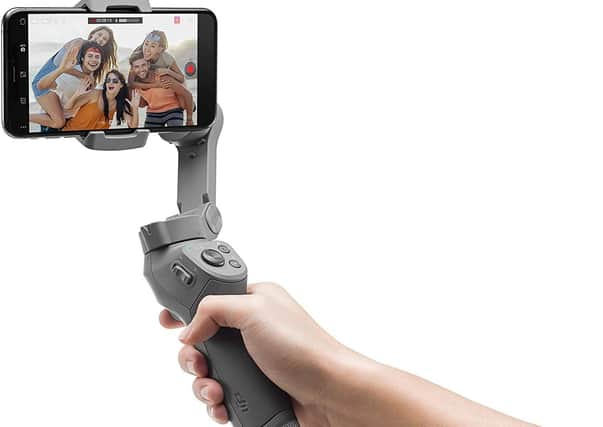Gimbals are smart selfie sticks that can transform your photography


The lenses and processors on modern smartphones are so advanced now that dedicated video cameras are all but redundant for everyday filmmaking. And even though not many phones have zoom lenses, the two or three fixed lenses they do have will give you enough coverage for most situations.
It’s increasingly common for phones to also have image stabilisers, which electronically cancel out the effects of sudden hand movement. But you’ll get far better results with a mechanical contraption that uses motors and sensors to keep the picture upright and fluid.
Advertisement
Hide AdAdvertisement
Hide AdThese are known as gimbals, and although the technology is far from new, the migration from camcorders to phones has created a market in small and affordable models that have become indispensable accessories for even the most casual videographer..
Until recently, using a gimbal involved the outlay of several hundred pounds, and for that reason they were the preserve of professional filmmakers. That was until someone had the idea of putting them onto selfie sticks and mass producing them. The result is that you can now pick one up for less than £80, carry it around in your bag and clip it to your phone whenever you want. It will enhance almost any shot without interfering with the phone itself.
Cheap, foldable gimbals such as the DJI Osmo Mobile 3, are similar at first glance to the pistol grips you used to find on home cine cameras. But they conceal a system of weights and silent motors that compensate for the pitch and roll to which any hand-held object is normally subjected. The best models do this across three separate axes, sending movement data to an inbuilt processor which calculates how much countermovement is needed on each axis.
By selecting from a choice of preset modes covering normal camera operations like pans and zooms, the device can work out whether a movement is intentional or not, and compensate accordingly. The results are as close as you can get to a Hollywood-style Steadicam at pocket money prices.
Advertisement
Hide AdAdvertisement
Hide AdGimbals are ideal for following a subject from room to room, or down a street. Used with care, your camera can appear to be floating on air as it tracks the movement. And because the phone is at arm’s length, you can get a better viewpoint without risking dropping it.
You can also control the phone itself from the handle by using a companion app that connects the two together via Bluetooth. This makes it possible to zoom in or switch lenses by using a slider on the gimbal. The only downside is that the unit adds about a pound to the weight of your phone.
The heft is one of the features to consider when choosing a phone gimbal. Check also whether it works on three axes or just two, and that the included app is compatible with your make of phone. You might also want to consider models that also function as tabletop tripods.
Gimbals are also available for GoPro action camcorders and for most types of digital still cameras, which of course are also capable of shooting video. They really come into their own on drones, which rely on being kept upright and level with the horizon.
Advertisement
Hide AdAdvertisement
Hide AdBut if you want to keep your kit to a minimum, you can choose an all-in-one gimbal camera such as the £240 Benro Snoppa Vmate, which shoots both still and ultra high definition video images, and weighs only around four ounces.
Support The Yorkshire Post and become a subscriber today. Your subscription will help us to continue to bring quality news to the people of Yorkshire. In return, you’ll see fewer ads on site, get free access to our app and receive exclusive members-only offers. Click here to subscribe.
Comment Guidelines
National World encourages reader discussion on our stories. User feedback, insights and back-and-forth exchanges add a rich layer of context to reporting. Please review our Community Guidelines before commenting.